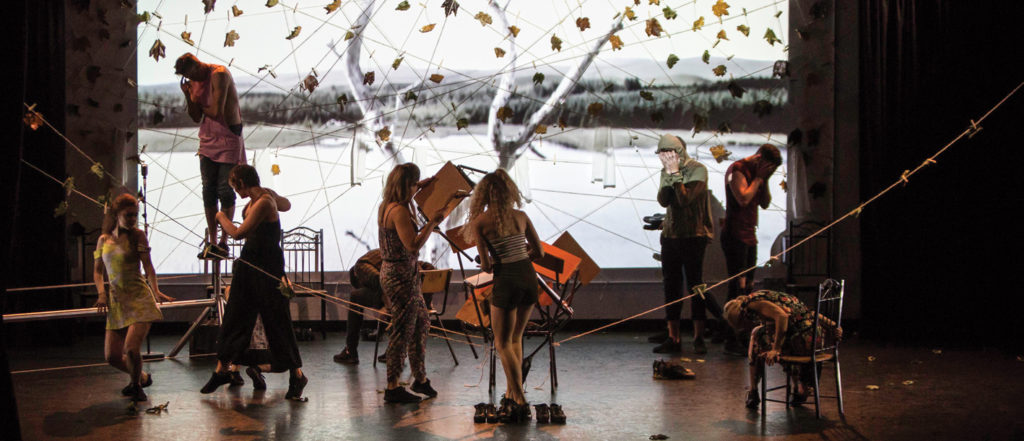Ériu Dance Company: Breandán de Gallaí / Aon - Vancouver Ballet Society
- Home
- Reviews 2014 - 2019
- Ériu Dance Company: Breandán de Gallaí / Aon

Breandán de Gallaí’s Aon premiered in August at the Firkin Crane theatre — a medium-sized venue that presents only dance — in Cork, Ireland. It was performed by de Gallaí’s Dublin-based Ériu Dance Company, founded as a vehicle for his choreography in 2010. Since then, the company has premiered three significant works, including The Rite of Spring to the well-known Stravinsky score.
De Gallaí is a world champion Irish dancer who made his name in the lead role in the original production of Riverdance. He also has a background in ballet, contemporary, jazz and tap. As a choreographer, he aims to create works that connect Irish dance with contemporary dance and themes, as he does in the two-part, 70-minute Aon.
Perhaps realizing the shortcomings of the Irish dance tradition in terms of emotional communication in what is an emotionally charged theme, de Gallaí attempts a fusion not just of different styles of dance, but he also uses text to highlight the core of the story, which, in the program notes, he says “is about identifying who we really are — the me that longs to be seen.” Each half of Aon — which means alone or one in Irish — had a number of sections under various headings: Love me, please love me; Remember Me; Breaking Free; Liberation, etc., which served as emotional signposting for the viewer.
The company’s 12 dancers, dressed in contemporary street clothes, were strong, committed and highly skilled. They switched from dance sneakers, for the soft shoe choreography, to Irish hard shoes, for batterie and more rhythmic material, changing back and forth, their steps creating a counterpoint with the music.
The movement came from the Irish tradition but with more contemporary inflections, especially with the freedom in the upper body and arms that is reminiscent of Pina Bausch, Merce Cunningham and Martha Graham, and even some circus in the form of tightrope walking. How well these were fused together is up for debate. At times the work looked awkward, with angst-ridden head-in-hand moments, while in other places the wide use of space and sense of fluidity in the upper body and arms created an expressive foil to the more traditionally stoic lower body material.
De Gallaí’s use of the ensemble was impressive throughout, with the movement taking the dancers across the stage like groups of geese in flight — organized, powerful and a joy to watch. However, he seemed to turn away from the work’s emotional core by indulging in some incongruous Riverdance-esque flanking. The end of the work was baffling, too, for having spent much of his time avoiding hard-hitting emotion, de Gallaí blatantly indulges in an orgy of smiles and lines of beating dancers.
The inventive set, designed by Declan English, begins as a stack of chairs intertwined with cords from which hang autumn leaves. At the beginning, each performer frantically takes and rearranges the leaves while pre-recorded text of their online dating profiles points us toward the idea that this action represents their personal traits being rearranged as they search for love.
Meanwhile, the chairs are taken apart and moved to a line against the back of the stage where they remain. The performers take to a tightrope on the left-hand side, now reciting their dating profiles, only to lose balance and fall off. At one point, a small group of three dancers recited sections of a gritty and emotionally charged poem, Bluebird, by maverick American underground writer Charles Bukowski. These sections create an atmosphere that begins to explore the isolation felt while dating in this tech-heavy world.
Toward the end of the first half, the dancing stops, time stands still and we are transported to what feels like the heart of the work. A lone dancer takes the lead and, in the evening’s most remarkable moment, Sarah Fennel sang Dido’s Lament from Purcell’s Dido and Aeneas in a traditional unaccompanied style of Irish singing called sean-nós, characterized by mellifluous melodic decoration and a certain nasal tone. The rest of the music, a pre-recorded soundtrack, was a mixture of Irish, classical and contemporary beautifully mixed and arranged by Paddy Mulcahy, an Irish composer and musician.
Aon was an audience-pleaser and reportedly received standing ovations at every performance. However, the dramatic potential for a deeper work that really hits home with the isolation and desperation as well as the elation and highs of dating using the new field of apps and websites was left unexplored.
— DAVID WALLACE
DI WINTER 2017

Photo: Declan English
